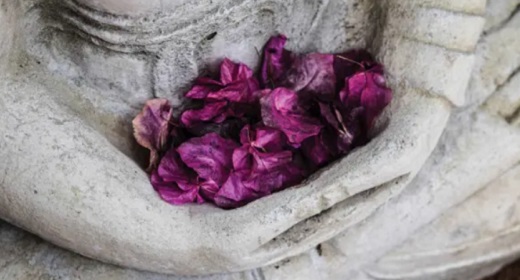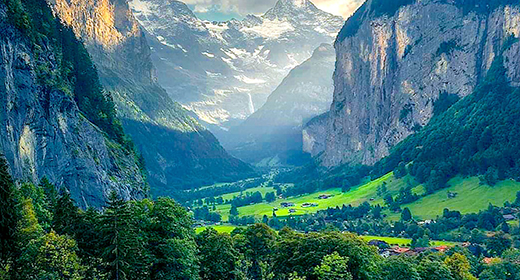Lama Tsultrim Allione—one of the first American woman ordained as a Tibetan Buddhist nun..
shares what she’s learned about love, life, and liberty while researching dakinis, or fierce female messengers of wisdom.
When I was eleven, I ran home on the last day of school and tore off my dress, literally popping the buttons off, feeling simultaneously guilty and liberated. I put on an old, torn pair of cutoff jean shorts, a white T-shirt, and blue Keds sneakers, and ran with my sister into the woods behind our old colonial New Hampshire house. We went to play in the brook burbling down the steep hill over the mossy rocks, through the evergreens and deciduous trees, the water colored rich red-brown by the tannins in the leaves of the maple trees. We would play and catch foot-long white suckerfish with our hands, and then put them back because we didn’t want to kill them.
Sometimes we swam naked at night with friends at our summerhouse in the spring-fed lake 15 miles away, surrounded by pine, birch, spruce, and maple trees. I loved the feeling of the water caressing my skin like velvet, with the moon reflecting in the mirror-like lake. My sister and my friend Joanie and I would get on our ponies bareback and urge them into the lake until they were surging up and down with water rushing over our thighs and down the backs of the horses; they were swimming with us as we laughed, clinging onto their backs.
When violent summer thunderstorms blew through, instead of staying in the old wooden house I would run and dance outside in the rain and thunder, scaring my mother. I liked to eat with my fingers, gnawing on pork chop bones and gulping down big glasses of milk, in a hurry to get back outside. I loved gnawing on bones. My mother would shake her head, saying in desperation, “Oh, darling, please, please eat with your fork! Heavens alive, I’m raising a barbarian!”
Barbarian, I thought, that sounds great! I imagined women with long hair streaming out behind them, racing their horses over wide plains. I saw streaked sunrises on crisp mornings with no school, bones to gnaw on. This wildness was so much a part of me; I could never imagine living a life that didn’t allow for it.
But then I was a wife and a mother raising two young daughters, and that wild young barbarian seemed lifetimes away. Paul and I had been married for three years when we decided to move from Vashon Island back to Boulder, Colorado, and join Trungpa Rinpoche’s community. It was wonderful to be in a big, active community with many young parents. However, the strain of the early years, our inexperience, and our own individual growth led us to decide to separate and collaborate as co-parents.
In 1978, I had been a single mother for several years when I met an Italian filmmaker, Costanzo Allione, who was directing a film on the Beat poets of Naropa University. He interviewed me because I was Allen Ginsberg’s meditation instructor, and Allen, whom I had met when I was a nun in 1972, introduced me to Costanzo. In the spring of 1979, we were married in Boulder while he was finishing his film, which was called Fried Shoes Cooked Diamonds, and soon thereafter we moved to Italy. I got pregnant that summer while we were living in a trailer in an Italian campground on the ocean near Rome, and that fall we moved into a drafty summer villa in the Alban Hills near the town of Velletri.
When I was six months pregnant, my belly measured the size of a nine-months pregnant woman’s, so they did an ultrasound and discovered I was pregnant with twins. By this time I knew that my husband was a drug addict and unfaithful. I couldn’t speak the native language and felt completely isolated. In March of 1980, I gave birth to twins, Chiara and Costanzo; they were a little early, but each weighed over five pounds. I buckled down to nursing two babies, caring for my other two daughters, and dealing with my husband’s addiction, erratic mood swings, and physical abuse, which started during my pregnancy when he began to hit me.
My feelings of overwhelm and anxiety increased daily, and I began to wonder about how my life as a mother and a Western woman really connected with my Buddhist spirituality. How had things ended up like this? How had I lost that wild, independent girl and left my life as a nun, ending up in Italy with an abusive husband? It seemed that by choosing to disrobe, I had lost my path, and myself.
Then two months later, on June 1, 1980, I woke up from a night of broken sleep and stumbled into the room where Chiara and her brother Costanzo were sleeping. I nursed him first because he was crying, and then turned to her. She seemed very quiet. When I picked her up, I immediately knew: she felt stiff and light. I remembered the similar feeling from my childhood, picking up my small marmalade colored kitten that had been hit by a car and crawled under a bush to die. Around Chiara’s mouth and nose was purple bruising where blood had pooled; her eyes were closed, but her beautiful, soft amber hair was the same and she still smelled sweet. Her tiny body was there, but she was gone. Chiara had died of sudden infant death syndrome.
The Buddhist stupa of Swayambhu in the Kathmandu Valley, Nepal.
Bikalpa Pokhrel
The Dakini Spirit
Following Chiara’s death came what I can only call a descent. I was filled with confusion, loss, and grief. Buffeted by raw, intense emotions, I felt more than ever that I desperately needed some female guidance. I needed to turn somewhere: to women’s stories, to women teachers, to anything that would guide me as a mother, living this life of motherhood—to connect me to my own experience as a woman and as a serious Buddhist practitioner on the path. I needed the stories of dakinis—fierce female messengers of wisdom in Tibetan Buddhism. But I really didn’t know where to turn. I looked into all kinds of resources, but I couldn’t find my answers.
At some point in my search, the realization came to me: I have to find them myself. I have to find their stories. I needed to research the life stories of the Buddhist women of the past and see if I could discover some thread, some key that would help unlock the answers about the dakinis and guide me through this passage. If I could find the dakinis, I would find my spiritual role models—I could see how they did it. I could see how they made the connections between mother, wife, and woman . . . how they integrated spirituality with everyday life challenges.
About a year later, I was in California doing a retreat with my teacher, Namkhai Norbu Rinpoche, who was teaching a practice called Chöd that involved invoking the presence of one of the great female masters of Tibetan Buddhism, Machig Labdrön. And in this practice there is an invocation, in which you visualize her as a young, dancing, 16-year-old white dakini. So there I was doing this practice with him, and for some reason that night he kept repeating it. We must have done it for several hours. Then during the section of the practice where we invoked Machig Labdrön, I suddenly had the vision of another female form emerging out of the darkness.
What I saw behind her was a cemetery from which she was emerging. She was old, with long, pendulous breasts that had fed many babies; golden skin; and gray hair that was streaming out. She was staring intensely at me, like an invitation and a challenge. At the same time, there was incredible compassion in her eyes. I was shocked because this woman wasn’t what I was supposed to be seeing. Yet there she was, approaching very close to me, her long hair flowing, and looking at me so intensely. Finally, at the end of this practice, I went up to my teacher and said, “Does Machig Labdrön ever appear in any other forms?”
He looked at me and said, “Yes.” He didn’t say any more.
I went to bed that night and had a dream in which I was trying to get back to Swayambhu Hill in Nepal, where I’d lived as a nun, and I felt an incredible sense of urgency. I had to get back there and it wasn’t clear why; at the same time, there were all kinds of obstacles. A war was going on, and I struggled through many barriers to finally reach the hill, but the dream didn’t complete itself. I woke up still not knowing why I was trying to return.
The next night I had the same dream. It was slightly different, and the set of obstacles changed, but the urgency to get back to Swayambhu was just as strong. Then on the third night, I had the same dream again. It is really unusual to have the same dream again and again and again, and I finally realized that the dreams were trying to tell me I had to go back to Swayambhu; they were sending me a message. I spoke to my teacher about the dreams and asked, “Does this seem like maybe I should actually go there?”
He thought about it for a while; again, he simply answered, “Yes.”
I decided to return to Nepal, to Swayambhu, to find the stories of women teachers. It took several months of planning and arrangements, a key part being to seek out the biographies of the great female Buddhist teachers. I would use the trip to go back to the source and find those yogini stories and role models I so desperately needed. I went alone, leaving my children in the care of my husband and his parents. It was an emotional and difficult decision, since I had never been away from my children, but there was a deep calling within me that I had to honor and trust.
Back in Nepal, I found myself walking up the very same staircase, one step after another, up the Swayambhu Hill, which I had first climbed in 1967. Now it was 1982, and I was the mother of three. When I emerged at the top, a dear friend of mine was there to greet me, Gyalwa, a monk I had known since my first visit. It was as though he was expecting me. I told him I was looking for the stories of women, and he said, “Oh, the life stories of dakinis. Okay, come back in a few days.”
And so I did. When I returned, I went into his room in the basement of the monastery, and he had a huge Tibetan book in front of him, which was the life story of Machig Labdrön, who’d founded the Chöd practice and had emerged to me as a wild, gray-haired dakini in my vision in California. What evolved out of that was research, and eventually the birth of my book Women of Wisdom, which tells my story and provides the translation of six biographies of Tibetan teachers who were embodiments of great dakinis. The book was my link to the dakinis, and it also showed me, from the tremendous response the book received, that there was a real need—a longing—for the stories of great women teachers. It was a beautiful affirmation of the need for the sacred feminine.
Learn how to step into your feminine power.
Brooke Lark
Coming Out of the Dark
During the process of writing Women of Wisdom, I had to do research on the history of the feminine in Buddhism. What I discovered was that for the first thousand years in Buddhism, there were few representations of the sacred feminine, although there were women in the Buddhist sangha (community) as nuns and lay householder devotees, and the Buddha’s wife and the stepmother who raised him had a somewhat elevated status. But there were no female buddhas and no feminine principles, and certainly no dakinis. It was not until the traditional Mahayana Buddhist teachings joined with the Tantric teachings and developed into Vajrayana or Tantric Buddhism in the eighth century, that we began to see the feminine emerge with a larger role.
Before we continue, I want to distinguish here between neo-Tantra and more traditional Tantric Buddhism. Most people these days who see the word Tantra think about neo-Tantra, which has developed in the West as a form of sacred sexuality derived from, but deviating significantly from, traditional Buddhist or Hindu Tantra. Neo-Tantra offers a view of sexuality that contrasts with the repressive attitude toward sexuality as nonspiritual and profane.
Buddhist Tantra, also known as Vajrayana (Indestructible Vehicle), is much more complex than neo-Tantra and embedded in meditation, deity yoga, and mandalas—it is yoga with an emphasis on the necessity of a spiritual teacher and transmission. I will use the words Tantra and Vajrayana interchangeably throughout this book. Tantra uses the creative act of visualization, sound, and hand gestures (mudras) to engage our whole being in the process of meditation. It is a practice of complete engagement and embodiment of our whole being. And within Buddhist Tantra, often sexuality is used as a meta-phor for the union of wisdom and skillful means. Although sexual practice methods exist, Buddhist Tantra is a rich and complex spiritual path with a long history, whereas neo-Tantra is an extraction from traditional Tantric sexual practices with some additions that have nothing to do with it. So here when I say Tantra or Vajrayana, I am referring not to neo-Tantra but to traditional Buddhist Tantra.
Tantric Buddhism arose in India during the Pala Empire, whose kings ruled India primarily between the eighth and eleventh centuries. Remember that Buddhism had already existed for more than a thousand years by this time, so Vajrayana was a late development in the history of Buddhism. The union of Buddhism and Tantra was considered to be in many ways the crown jewel of the Pala period.
Although the origins of Buddhist Tantra are still being debated by scholars, it seems that it arose out of very ancient pre-Aryan roots represented in Shaktism and Saivism combining with Mahayana Buddhism. Though there is still scholarly debate about the origins of Vajrayana, Tibetans say it was practiced and taught by the Buddha. If we look at the Pala period, we find a situation where the Buddhist monks have been going along for more than a thousand years, and they have become very intellectually astute, developing various schools of sophisticated philosophy, Buddhist universities, and a whole culture connected to Buddhism that is very strong and alive. But at this point the monks have also become involved with politics, and have begun to own land and animals and to receive jewels and other riches as gifts from wealthy patrons. They also have become rather isolated from the lay community, living a sort of elite, intellectual, and rather exclusive existence.
The Tantric revolution—and it was a revolution in the sense that it was a major turning point—took place within that context. When the Tantric teachings joined Buddhism, we see the entrance of the lay community, people who were working in the everyday world, doing ordinary jobs and raising children. They might come from any walk of life: jewelers, farmers, shopkeepers, royalty, cobblers, blacksmiths, wood gatherers, to name a few. They worked in various kinds of occupations, including housewives. They were not monks who had isolated themselves from worldly life, and their spiritual practice reflected their experiences. There are many early tales, called the Siddha Stories, of people who lived and worked in ordinary situations, and who by turning their life experiences into a spiritual practice achieved enlightenment.
There are also some stories of enlightened women practitioners and teachers in early Buddhism. We see a blossoming of women gurus, and also the presence of female Buddhas and, of course, the dakinis. In many stories, these women taught the intellectual monks in a very direct, juicy way by uniting spirituality with sexuality; they taught based on using, rather than renouncing, the senses. Their teachings took the learned monks out of the monastery into real life with all its rawness, which is why several of the Tantric stories begin with a monk in a monastic university who has a visitation from a woman that drives him out in search of something beyond the monastic walls.
Tantric Buddhism has a genre of literature called “praise of women,” in which the virtues of women are extolled. From the Candamaharosana Tantra: “When one speaks of the virtues of women, they surpass those of all living beings. Wherever one finds tenderness or protectiveness, it is in the minds of women. They provide sustenance to friends and strangers alike. A woman who is like that is as glorious as Vajrayogini herself.”
There is no precedent for this in Buddhist literature, but in Buddhist Tantric texts, writings urge respect for women, and stories about the negative results of failing to recognize the spiritual qualities of women are present. And in fact, in Buddhist Tantra, the fourteenth root of downfall is the failure to recognize all women as the embodiment of wisdom.
In the Tantric period, there was a movement abolishing barriers to women’s participation and progress on the spiritual path, offering a vital alternative to the monastic universities and ascetic traditions. In this movement, one finds women of all castes, from queens and princesses to outcasts, artisans, winemakers, pig herders, courtesans, and housewives.
For us today, this is important as we are looking for female models of spirituality that integrate and empower women, because most of us will not pursue a monastic life, yet many of us have deep spiritual longings. Previously excluded from teaching men or holding positions of leadership, women—for whom it was even questioned whether they could reach enlightenment—were now pioneering, teaching, and assuming leadership roles, shaping and inspiring a revolutionary movement. There were no institutional barriers preventing women from excelling in this tradition. There was no religious law or priestly caste defining their participation.
Dakini Symbols
Another important part of the Tantric practice is the use of symbols surrounding and being held by the deities. The first and probably most commonly associated symbol of the dakini is what’s called the trigug in Tibetan, the kartari in Sanskrit, and in English, “the hooked knife.” This is a crescent-shaped knife with a hook on the end of the blade and a handle that is ornamented with different symbols. It’s modeled from the Indian butcher’s knife and sometimes called a “chopper.” The hook on the end of the blade is called the “hook of compassion.” It’s the hook that pulls sentient beings out of the ocean of suffering. The blade cuts through self-clinging, and through the dualistic split into the great bliss. The cutting edge of the knife is representative of the cutting quality of wisdom, the wisdom that cuts through self-deception. To me it is a powerful symbol of the wise feminine, because I find that often women tend to hang on too long and not cut through what needs to be cut through. We may hang on to relationships that are unhealthy, instead of ending what needs to be ended. The hooked knife is held in the dakini’s raised right hand; she must grasp this power and be ready to strike. The blade is the shape of the crescent moon, and the time of the month associated with the dakini is ten days after the full moon, when the waning moon appears as a crescent at dawn; this is the twenty-fifth day of the lunar cycle and is called Dakini Day in the Tibetan calendar. When I come out early on those days and it is still dark, I look up and see the crescent moon; it always reminds me of the dakini’s knife.
The other thing about the dakinis is that they are dancing. So this is an expression when all bodily movements become the expression of enlightened mind. All activities express awakening. Dance is also an expression of inner ecstasy. The dakini has her right leg raised and her left leg extended. The raised right leg symbolizes absolute truth. The extended left leg rests on the ground, symbolizing the relative truth, the truth about being in the world, the conventional truth. She’s also naked, so what does that mean? She symbolizes naked awareness—the unadorned truth, free from deception. And she is standing on a corpse, which symbolizes that she has overcome self-clinging; the corpse represents the ego. She has overcome her own ego.
The dakini also wears bone jewelry, gathered from the charnel-ground bones and carved into ornaments: She wears anklets, a belt like an apron around her waist, necklaces, armbands, and bracelets. Each one of these has various meanings, but the essential meaning of all the bone ornaments is to remind us of renunciation and impermanence. She’s going beyond convention; fear of death has become an ornament to wear. We think of jewels as gold or silver or something pretty, but she’s taken that which is considered repulsive and turned it into an ornament. This is the transformation of the obstructed patterns into wisdom, taking what we fear and expressing it as an ornament.
The dakinis tend to push us through blockages. They appear during challenging, crucial moments when we might be stymied in our lives; perhaps we don’t know what to do next and we are in transition. Maybe an obstacle has arisen and we can’t figure out how to get around or get through—then the dakinis will guide us. If in some way we’re stuck, the dakinis will appear and open the way, push us through; sometimes the energy needs to be forceful, and that’s when the wrathful manifestation of a dakini appears. Another important aspect of the dakini’s feminine energy is how they cut through notions of pure and impure, clean and unclean, what you should do and shouldn’t do; they break open the shell of those conventional structures into an embrace of all life in which all experience is seen as sacred.
Practicing Tibetan Buddhism more deeply, I came to realize that the dakinis are the undomesticated female energies—spiritual and erotic, ecstatic and wise, playful and profound, fierce and peaceful—that are beyond the grasp of the conceptual mind. There is a place for our whole feminine being, in all its guises, to be present.










































